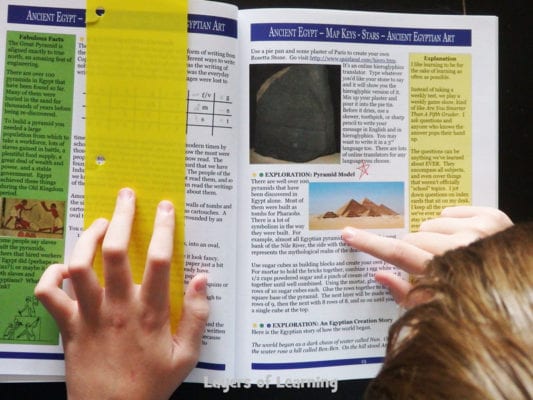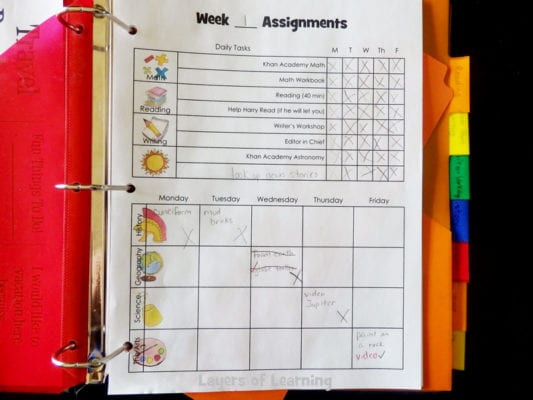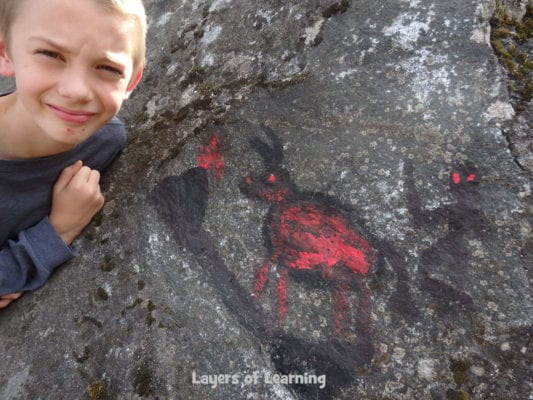Layers of Learning is a family curriculum and we think group learning is one of its best strengths. But the truth is your circumstances may not be ideal for gathering everyone around in the living room and learning together. You might need your kids to be more independent. We’ll show you how to help kids use Layers of Learning more independently, while still taking advantage of the hands-on learning style.
Once a Week Planning
The first step is to sit down with your child or children once a week, maybe Friday afternoon or Sunday evening or whenever you will have a consistent moment to map out their next week’s work. Flip through the Layers of Learning unit you are currently on and have them choose explorations that they like and can complete on their own.

Bookmark the explorations they choose with a sticky note or with a highlighter right in the book. If you are using the digital version, print out just the pages their explorations are on.
Then have them write down their chosen explorations in a student planner. If you want independent kids, a planner is a necessity. They have to see each day’s expectations and be able to check tasks off as they are completed.

Gather Materials
As soon as you are finished planning explorations have your kids gather the supplies they will need for the week’s projects and put them on one shelf, in one bin, or in a single bag. This is the NO EXCUSES step, because they will have everything they need for the projects. You can confidently expect them to finish the assigned work. Print any printables they will need for the week and have them put the printables in their notebook or with their other school supplies.
If there are supplies you don’t have, then put them on your shopping list and make sure you put the project they go with on a day after your shopping trip will happen. Remember that the subjects (history, geography, science, and arts) don’t have to be competed in any particular order, so adjust your schedule so it will work with the rest of your family life. Also, feel free to veto any projects that you know they can’t actually complete on their own or that use supplies you will not be able to obtain in a reasonable amount of time.
The Library List
Every unit contains a library list. How your kids use this independently will depend on the reading prowess of your children. If your kids are great readers then you can probably just put library books that go with the unit on hold at your library, swing by to pick them up once a week, and put “Independent Reading – 40 min” in their planner and tell them they can choose any books out of your library basket (or shelf or wherever you collect library books).
If your kids aren’t such great readers then you can ignore the library list all together (and use videos instead), choose one book per week you will read together (it can be a picture book), or chose a book below your child’s grade level and assign that one book to be read all week. Layers of Learning books should not be reading instruction. They should be books that are used to gain information. Your child can’t gain information if he can’t read the book with some ease. The goal is to make them love to learn. Don’t forget the goal!
Reading instruction is a different subject, treat it separately.
How Michelle does it with reluctant readers
With my younger kids, who are not great readers, I send them video links in their email (check out QuietTube if you are worried about all the places your child could end up on YouTube unsupervised). This is where they get most of their information. I have them write “video” in their planner and they know to look at their email for the links.
Two things help enormously with this.
- Layers of Learning has YouTube playlists of videos already curated. Search YouTube for “Layers of Learning Unit 1-2” or whichever unit you are on. This will save lots of time in finding videos.
- Scheduling the emails to my kids with the video links so they appear in their inboxes on the days I want them to watch the videos. This way I can find and plan the videos right after our Sunday evening meeting and not worry about scrambling (or remembering) during the week.
Then once a week, we read the Usborne Encyclopedia of World History, DK Encyclopedia of Science, and/or The Arts: A Visual Encyclopedia together in the evening when I am checking the rest of their school work. We do a narration page or work on our Book of Years right after reading the encyclopedia. I don’t do all of these encyclopedias every week, I pick one. I space it out. Because my time is severely limited. But this does help me feel like I have a handle on what my kids are learning and they aren’t missing big chunks or failing to grasp how the projects they did during the week relate to anything else. They know the mud bricks were crafted because that is how the ancient Mesopotamians built their houses.
Vigilance
The last thing you have to do to make the whole “independent” thing work is to constantly check up on them. Very few people, even adult people, are really independent. Hold them accountable. Someone has to check up to see if they are really doing their work. So every afternoon I check my children’s work to see if they did it, to see if they got stuck on anything, to see if we need to make adjustments. If they didn’t finish, either I help them finish or I assign it for the next day. Stickers and evening games and snacks with Mom induce them to get all the work done each day.

Really this checking up needs to be daily. If they complete their work it only takes a few minutes. If they need help it can take a half hour or an hour or (if it’s more time on a regular basis, you need to make some curriculum adjustments or maybe some attitude adjustments). You know best if your child really needs help or if they are shamming.
How to Use Layers of Learning More Independently
Here are the main steps to take to help your kids use Layers of Learning more independently:
- Plan weekly where you write the projects in a planner to complete during the following week.
- Have a library basket or send video links for extra fact learning.
- Once or twice a week read an encyclopedia entry or book together. Do narrations or a Book of Years together, once a week or so.
- Check up on work daily!
Some Caveats
If your children are very young this simply will not work. If they can’t read at all or manipulate the glue stick or cut with scissors by themselves, then they need you there. They are too young to be on their own anyway if they are younger than about 8 or so. My youngest is 10 and he has big brothers at home to help with things that are too hard while I am away. But if you have kids in the middle grades or high school they can use Layers of Learning independently.
If you have tips, tricks, or ideas on how your kids have used Layers of Learning independently, leave a comment below!
Get a Free Unit
Choose between the first unit in each Layers of Learning subject to try for free when you sign up for the newsletter.
We never spam and you can cancel your subscription at any time.


